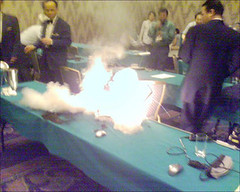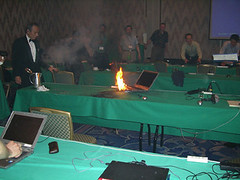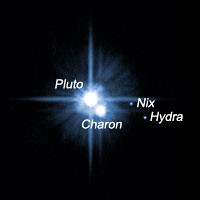Your Phone, Your Brain & Your Nose
Friday, June 30th, 2006There have been some pretty interesting stories circulating about mobile phones this week, and now seems like a good time to encapsulate them all in one place (especially considering the one that landed in my inbox this morning).
You’ve probably heard about the alleged connection between mobile phones and brain cancer (And who can forget the Canadian University that banned wifi because of health concerns?) Well, the FDA says there’s no clear connection between (pun intended?) the two, but new research from Italy suggests that your cellphone may be stimulating a part of your brain.
Dr. Paolo Rossini of Fatebenefratelli hospital in Milan and colleagues used Transcranial Magnetic Stimulation or TMS to check brain function while people used these phones.
They had 15 young male volunteers use a GSM 900 cell phone for 45 minutes. In 12 of the 15, the cells in the motor cortex adjacent to the cell phone showed excitability during phone use but returned to normal within an hour.
The cortex is the outside layer of the brain and the motor cortex is known as the "excitable area" because magnetic stimulation has been shown to cause a muscle twitch.
The science blogger over at Retrospectacle mentions a Japanese study that yielded similar results, and notes that the motor cortex is affected (and temporarily at that, according to both studies) but not the sensory cortex where the visual, auditory, and olfactory (site, sound, and smell) regions of the brain reside.
That might be true, but according to another set of researchers chatting on your cellphone while driving (even with hands-free accessories) makes you just as impaired as a drunk driver. And just as dangerous too.
The researchers used a driving simulation device for their study, published in the summer 2006 issue of Human Factors: The Journal of the Human Factors and Ergonomics Society.
They studied 40 volunteers who used a driving simulator four times — while undistracted, using a handheld cell phone, using a hands-free cell phone and while intoxicated to a 0.08 percent blood-alcohol level — the average legal level of impairment in the United States — after drinking vodka and orange juice.
Three study participants rear-ended the simulated car in front of them. All were talking on cellphones and none was drunk, the researchers said.
Motorists who talked on either handheld or hands-free cell phones drove slightly more slowly, were 9 percent slower to hit the brakes, and varied their speed more than undistracted drivers.
Drivers with an 0.08 percent blood-alcohol level drove a bit more slowly than both undistracted drivers and telephone users, yet more aggressively.
And if your cellphone isn’t distracting enough when you’re driving, imagine how much more distracting it might be if there were smells coming from your cellphone. I kid you not. Trendhunter led me to this article about some researchers working to turn your cellphone into a smellphone.
Engineers have already developed a system that can record smells of various fruits, such as apples, oranges, melons and bananas, on to a system of 15 microchips in a handheld device.
Each microchip is an electronic ‘nose’, containing a chemical sensor which can pick up different traces in the odour.
The Japanese inventors of the system say these sensors can come up with thousands of different combinations.
The proportions of each odour are carefully noted by the microchips and when the ‘recording’ is played back they recreate them from 96 manmade chemicals.
I can’t help wondering if the scientists involved in this project have really thought this through. There may be an actual use for this, but I can also think of some good reasons not to put the capability of recording and transmitting odors via cellphone into the hands of at least some people. Can’t you?
 AN INQUIRER READER attending a conference in Japan was sat just feet away from a laptop computer that suddenly exploded into flames, in what could have been a deadly accident.
AN INQUIRER READER attending a conference in Japan was sat just feet away from a laptop computer that suddenly exploded into flames, in what could have been a deadly accident. 
 In other Hubble news (see the post below), a pair of small moons orbiting Pluto, first photgraphed by the Hubble Telescope in 2005,
In other Hubble news (see the post below), a pair of small moons orbiting Pluto, first photgraphed by the Hubble Telescope in 2005, 